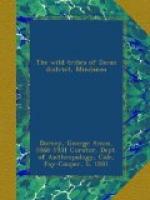No wild tribe in the archipelago has made so much use of silver in the production of ornaments as has the Mandaya. Thin silver plates are rolled into small tubes and are attached to the woman’s ear plugs (Fig. 49), finger rings of the same metal are produced in great numbers, but the finest work appears in the large silver ornaments worn on the breasts by both sexes (Fig. 53). Silver coins are beaten into thin disks, in the center of which a hole is cut. About this opening appear beautiful intricate designs, some engraved, others stamped with metal dies.
FIG. 53. SILVER BREAST ORNAMENTS.
All work in metal is limited to a few skilled men, but many lesser industries, such as shaping tortoise shell rings and shell bracelets, carving of spoons, and making baskets, are carried on by other members of the tribe during their leisure hours.
BIRTH
In each district there are one or two mid wives, known as managamon. They are women past middle life who are versed in the medicines and rites which should be employed at the time of birth. They are not considered as ballyan, yet they talk to the spirits upon certain occasions.
When a pregnant woman is about to be delivered the midwife crushes the bark of the dap-dap tree and makes a medicine called tagaumo, which she gives to the patient. It is claimed that this causes the muscles to relax so that they allow an easy delivery. The umbilical cord is cut with a bamboo knife and as soon as the child has been bathed it is given to the mother. The afterbirth is placed in a specially prepared basket and is either hung against the side of the house or in a nearby tree. For a few days the midwife assists about the house and then, if all is well with the child, she takes her payment of rice, chicken, and fish, and returns to her home. Should the child be ailing she will return, and having placed rice and betel-nut on banana leaves she carries these to the top of the house and there offers them to the asuang,[1] meanwhile asking those spirits to accept the offering and to cease troubling the child. No ceremony takes place at the time of naming or at the age of puberty, but at the latter period the teeth are filed and blackened so that the young person may be more beautiful and, therefore, able to contract a suitable marriage.
[1] See p. 176. [Transcriber’s note: This is page 192.]
MARRIAGE
Frequently parents arrange matches for their children while they are still very young, but in the majority of cases the matter is left until after the age of puberty when the wishes of the young people are taken into consideration. The youth or his father having chosen a suitable girl takes or sends a spear, knife, or other acceptable present to her father. If this offering is accepted it indicates approval of




